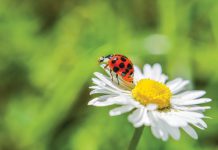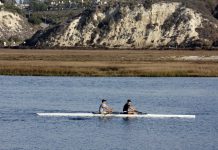Fear of the unknown often influences public projects.
I first met Dean Abernathy, full-time faculty and the co-chair of the architecture department of Orange Coast College, while working on a neighborhood project. Abernathy and OCC students took Google Earth, animated it with a computer program, incorporated potential controversial design elements and introduced motion as if driving down the actual street.
The visual graphics process garnered community support and a unanimous vote to approve the traffic calming project. Not an easy task.
Being inquisitive, I got myself invited to audit an architecture class, so I could see the students in action and observe the technology utilized. Abernathy was going over an assignment to purchase a model airplane kit.
“The first thing I want you to do is subvert the directions,” Abernathy told the students. The intent was to undermine the principles of the intended use, throw away the directions and make an architectural feature with the parts. Brilliant. How cool is a project like that?

Fast forward to this month, with students and teacher donating time and building work portfolio examples on a super-cool project. Here is a data-dump overview of the project. Valentine Woodworks, in Fullerton, hires an OCC graduate through a faculty connection. OCC Architecture Club goes with nonprofit charity called Corazon (Spanish for “heart”) to Tijuana, Mexico, five times a year to help build homes for families. Corazon also has a furniture build project. OCC Architecture connects Valentine Woodworks to Corazon for donations of excess/waste wood products that would have cost cold hard cash to dispose of, and will now will be made into furniture by OCC students and donated to Corazon.
That is the play-by-play, here is the color commentary. Valentine Woodworks makes high-quality office furniture and store fixtures. Try as they do, a small amount of waste exists in their sustainable manufacturing process. Tony Lenzini, a partner at Valentine frames it this way, “We like to give away the minimized waste created in an attempt to make others happy.”
After one project making Wyland Surfboards, a coworker came up with an idea to take scrap from another project and make small scale replicas of full size surfboards. Then the team went over to Children’s Hospital of Orange County to hand out joy to terminal patients. The cost of hauling waste is removed, as is the potential to wind up in a landfill.
Abernathy toured Valentine a couple years ago to form the foundation of a relationship. From there the relationship grew with internships and part-time work for OCC students and grads. Jesus DeLoya, an OCC graduate now working for Valentine, was obviously well educated on the ethics of trying to minimize waste. He internally facilitated the opportunity to connect excess material to the needy of families in Mexico.
OCC provides use of a truck to transport the wood to the students. Students are provided the challenge of takikng a small-scale project from concept to fabrication and into use. Students have to take all these pieces, contemplate how the pieces of the puzzle will go together in a piece of furniture, and utilize their classroom tools to fabricate it. Not just pretty pictures, but the full experience.
DeLoya will attend Long Beach State in the fall, for industrial design. You go, green friend.
Concepts have been completed. Prototypes built. Now the team is formulating the operational process to transform the pile of wood into comfortable chairs for needy families in Mexico. The chairs are being fabricated and then packed. The chair shipment will be coordinated with a Corazon trip later this month to Mexico, where the reveal and assembly will take place.
Perhaps the best news is that both sides of this sustainable equation, OCC and Valentine Woodworks, plan to continue the relationship and build a greener future.
In other great green news, the OCC students are working on a campus Bike Center. Many students ride bikes creating demand for a solution. Abernathy’s class has studied the opportunity and identified the optimal location. Their task is to design a structure on campus for bike storage and are also incorporating bolt-on entrepreneurial options like bike rentals and maintenance, a coffee shop and a juice bar. The class will use analytic and diagrammatic methods. The class will read the environment, analyze surroundings, interpret data and create form, finding a structure solution by gathering data from the built environment.
Ah, the form and function of our youth is truly inspiring.
What’s on your green mind? JimFitzEco@gmail.com




